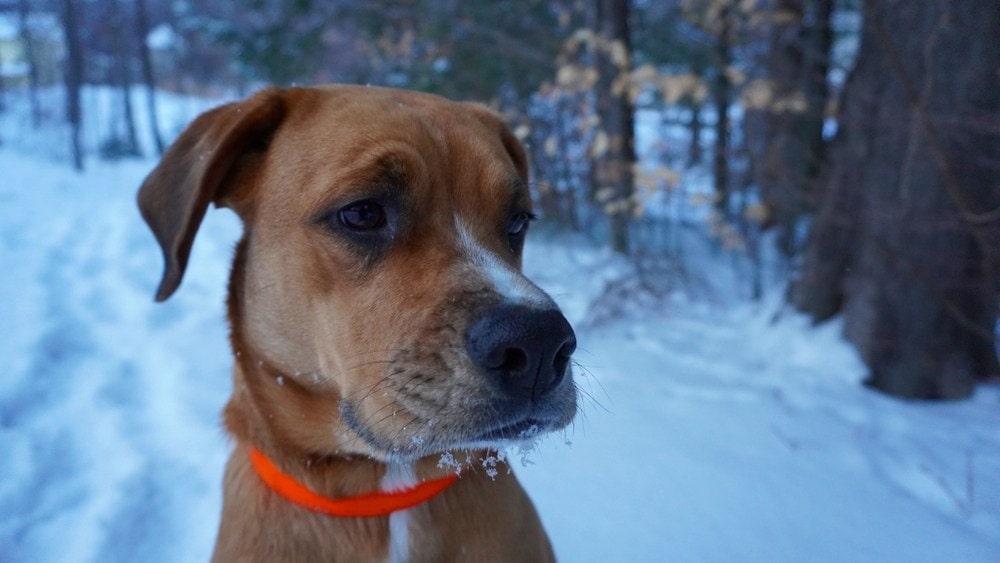Australian Boxherd (Australian Shepherd & Boxer Mix): Info, Pictures, Characteristics & Facts

Updated on

Height:
23–25 inches
Weight:
60–80 pounds
Lifespan:
12–15 years
Colors:
White, black, brown, golden
Suitable for:
Active families, those looking for a loyal, protective dog
Temperament:
Intelligent, easy to train, friendly, protective, energetic
The Australian Boxherd is a crossbreed of the Australian Shepherd and the Boxer. Both the Australian Shepherd (bred in the 19th century as a ranch dog) and the Boxer (bred in Germany) are energetic, loyal, and intelligent. The Boxherd gets a double dose of these traits, making it easily trainable, playful, and sociable.
The Boxherd is a medium to large size dog, but its exact weight and height will vary depending on the characteristics of the parent dog the pup takes after. Sometimes, the parent dog is not a Boxer or an Australian Shepherd purebred. This is called a multi-generational crossing.
Being a designer dog breed, the Boxherd has fewer health issues than purebreds.
Australian Boxherd Puppies
Australian Boxherds are descended from ranch dogs and are naturally protective. Pups need to be socialized at a young age to avoid any antisocial or aggressive behavior. Make sure that you establish authority early on, and make it clear that you are their master, not the other way round.
The Boxherd scores well on energy, trainability, lifespan, and sociability. However, some pups have flat faces, making them more susceptible to brachycephalic airway syndrome.
3 Little-Known Facts About the Australian Boxherd
1. They are also known as the Boxer Aussie mix.
2. One of their parents, the Australian Shepherd, is renowned for herding sheep and was bred in America.
3. The Boxer, their other parent, has roots dating back to 2,500 B.C.

Temperament & Intelligence of the Australian Boxherd🧠
These dogs are loyal and protective and tend to be physically active. If you are not much of an outgoing person, this Boxer Aussie mix may not be for you.
Like many other dog breeds, when Boxherds get bored, they may turn destructive, chewing on your shoes and generally making a nuisance of themselves.
Are These Dogs Good for Families?🏡 🐶 😽 🦴 🐕 🦮 ✂️ ❤️
When well trained, Boxherds will get along well with children. Their high intelligence means they will understand commands easily, and their obedience makes them easy to live with. Their protective nature endears them to many families.
However, these dogs have a strong herding background1, which may lead to negative behaviors, such as chasing moving objects. Some may even grow antisocial and aggressive. Such behavior may prove problematic when the dog grows bigger. It is, therefore, important to train and socialize the Australian Shepherd and Boxer Mix early in life.
If you have children, train them on how to interact with dogs. For example, they should know how and where to touch the dog (and where not to) to avoid any aggressive behavior. Again, basic rules such as not approaching the dog when they are eating or sleeping and not taking away the dog’s food should be well understood.
Does This Breed Get Along with Other Pets?🐶 😽
As mentioned above, these dogs have a herding background. They can get along well with other pets, especially when well-trained. Those who aren’t trained and socialized well will tend to herd the other pets. Keep an eye on your cats—they don’t like being herded.
Things to Know When Owning an Australian Boxherd
Food and diet requirements for this breed are similar to other breeds. Exercise, training, and grooming are just as important, as they affect the health of your pet.
Food & Diet Requirements🦴
The breeder you buy from should advise you on what to feed the dog, but you should follow a few guidelines:
- 6–10week-old puppies should be fed three times a day with softened hard food.
- Do not let the food sit for more than half an hour.
- Puppies older than 3 months should be fed twice a day with hard foods.
- Always ensure that your dog has a healthy weight. If they start to look obese, cut back on the amount of food.
- Pregnant and nursing dogs should be fed extra food. Start cutting back on the food after weaning the puppies.
Exercise 🐕
Exercise is important to keep your dog from negative and destructive behavior. On average, every dog requires at least an hour of exercise daily to keep them healthy. The Boxer Aussie mix has high energy levels, and often, an hour isn’t enough. Playing fetch, running, and swimming are good exercise options.
Some Boxherds have flat faces, making too much exercise a health risk. A dog with a flat face has a shortened skull with a compressed nasal cavity, which makes it harder to breathe. This is called brachycephalic airway syndrome, or congenital obstructive airway disease.
During exercise, this syndrome causes:
- Difficulty in taking in sufficient oxygen
- Overheating, since the dog cannot effectively control their core temperature by panting
You should avoid overexerting your dog in hot conditions, and if you have not yet bought the dog, avoid any puppies with flat faces. Go for pups with a pronounced muzzle. In doing so, you discourage the propagation of the flat face and obstructive airway disease.
Training🦮
Boxherds are intelligent and can be easily trained. They understand commands easily, and due to their natural inclination to obey, training them is a cinch. As with other dogs, training is most effective when the dog is young. If you find it challenging to train your dog, try signing them up for puppy training classes.
When you adopt a Boxherd, make sure you know their background. This includes asking the shelter worker or breeder certain questions:
- Ask whether the dog has exhibited any health issues in the past or during its stay in the rescue center.
- Ask about the dog’s behavior and whether they are exhibiting any negative behaviors.
- Ask whether the dog has been trained before or whether they show any signs of behavior training.
Grooming ✂️
The amount of grooming your pet will require will depend largely on your dog. If your Boxherd inherits the Australian Shepherd’s coat, shedding season will require more elbow grease on your part.
If the dog inherits the Boxer’s coat or a coat that is a combination of the Boxer’s and the Shepherd’s, weekly brushing will suffice.
Keep the dog’s nails well-trimmed and brush their teeth regularly. Avoid bathing the dog too many times; only do it if you deem it necessary. Use mild soaps to avoid irritating their skin.
- Also see: Best Dog Shampoos – Reviews & Top Picks
Health and Conditions❤️
As with most designer breeds, the Boxherd tends to suffer from only a few conditions. Hip dysplasia, cardiomyopathy, and degenerative myelopathy are the more serious ones. Cataracts, bloat, and epilepsy are minor conditions that crop up from time to time.
Male vs. Female
Females are slightly smaller and lighter than males. Some females have been observed to be more laidback, but do not expect this. The character of each individual is unique, and they do not have to inherit characteristics in a 50-50 ratio from their parents.
The choice of gender is up to you, but if you want to raise pups of your own, you might want to get a female. If you do not, however, the genders do not exhibit wildly different characteristics, and no gender-specific behavior has been observed.
Conclusion
The Australian Boxherd possesses an unrivaled work ethic, can be easily trained, and is protective of their family. These dogs are perfect for everyone but the most inactive dog lovers. They have a long lifespan of up to 15 years, provided you feed and treat them right.
See also:
- Australian Shepherd vs Border Collie: What’s the Difference?
- Border-Aussie (Border Collie & Australian Shepherd Mix): Pictures, Info, Facts
Featured Image Credit to: Ethan Akins, Shutterstock













